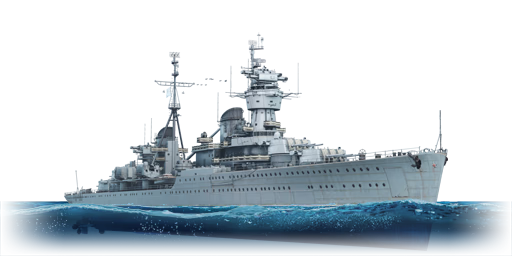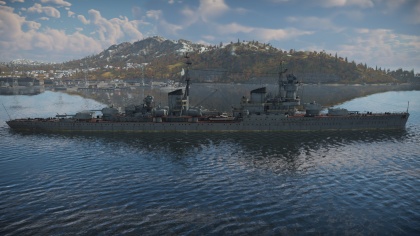Difference between revisions of "Chapayev"
(→Modules: Corrected typo) |
m (→Survivability and armour) (Tag: Visual edit) |
||
| Line 9: | Line 9: | ||
== General info == | == General info == | ||
=== Survivability and armour === | === Survivability and armour === | ||
| − | + | Strong armor against any and all 155mm shells, only constant AP fire from the likes of the USS Brooklyn will cause enough damage to put a dent in your crew. Against 8 inch shells it is recommended to angle your hull 45 degrees towards the attacker to avoid penetrating hits to your ammunition and engine comparments. Against the Graff Spee it is adviced to pray and/or hope he is using HE. | |
| + | |||
| + | Turrets are inmune to HE and AP shells from destroyers and secondary guns which are the main cause of "black turret syndrome" from which ships like the mogami and the Kirov suffer from a lot. Against cruiser HE they are very resistant and at best you might catch a lucky shell to one of the breeches which will disable only one out of the tree guns on the turret. | ||
| + | |||
| + | Deck armor is strong enough to resist 250kg bombs, but heavier ones will cause catastrophic damage. | ||
=== Mobility === | === Mobility === | ||
| − | + | Average max speed with somewhat quick acceleration, rudder is very responsive for a cruiser but the ship tends to list a lot from the smallest of rudder movements and takes a while to recover, which can mess up your accuracy. | |
== Armament == | == Armament == | ||
Revision as of 22:44, 15 September 2020
Contents
Description
The Pr.68-K, Chapayev, 1950 is a rank Russian cruiser
with a battle rating of (AB), (RB), and (SB). It was introduced in Update 1.91 "Night Vision".
General info
Survivability and armour
Strong armor against any and all 155mm shells, only constant AP fire from the likes of the USS Brooklyn will cause enough damage to put a dent in your crew. Against 8 inch shells it is recommended to angle your hull 45 degrees towards the attacker to avoid penetrating hits to your ammunition and engine comparments. Against the Graff Spee it is adviced to pray and/or hope he is using HE.
Turrets are inmune to HE and AP shells from destroyers and secondary guns which are the main cause of "black turret syndrome" from which ships like the mogami and the Kirov suffer from a lot. Against cruiser HE they are very resistant and at best you might catch a lucky shell to one of the breeches which will disable only one out of the tree guns on the turret.
Deck armor is strong enough to resist 250kg bombs, but heavier ones will cause catastrophic damage.
Mobility
Average max speed with somewhat quick acceleration, rudder is very responsive for a cruiser but the ship tends to list a lot from the smallest of rudder movements and takes a while to recover, which can mess up your accuracy.
Armament
Primary armament
Provide information about the characteristics of the primary armament. Evaluate their efficacy in battle based on their reload speed, ballistics and the capacity of their shells.
Broadly describe the ammunition available for the primary armament, and provide recommendations on how to use it and which ammunition to choose.
Secondary armament
Some ships are fitted with weapons of various calibres. Secondary armaments are defined as weapons chosen with the control Select secondary weapon. Evaluate the secondary armaments and give advice on how to use them. Describe the ammunition available for the secondary armament. Provide recommendations on how to use them and which ammunition to choose. Remember that any anti-air armament, even heavy calibre weapons, belong in the next section.
Anti-aircraft armament
An important part of the ship's armament responsible for air defence. Anti-aircraft armament is defined by the weapon chosen with the control Select anti-aircraft weapons. Talk about the ship's anti-air cannons and machine guns, the number of guns and their positions, their effective range, and about their overall effectiveness – including against surface targets.
Usage in battles
Describe the technique of using this ship, the characteristics of her use in a team and tips on strategy. Abstain from writing an entire guide – don't try to provide a single point of view, but give the reader food for thought. Talk about the most dangerous opponents for this vehicle and provide recommendations on fighting them. If necessary, note the specifics of playing with this vehicle in various modes (AB, RB, SB).
Modules
| Tier | Seakeeping | Unsinkability | Firepower | |||
|---|---|---|---|---|---|---|
| I | Dry-Docking | Tool Set | 152 mm B-35 AP | 100 mm ZS-56 HE | Anti-Air Armament Targeting | |
| II | Rudder Replacement | Fire Protection System | Smokescreen | 152 mm PB-35 SAP | 100 mm F-55 HE-F | Auxiliary Armament Targeting |
| III | Propeller Replacement | Shrapnel Protection | Ventilation | 152 mm ZS-35 AA | Improved Rangefinder | Primary Armament Targeting |
| IV | Engine Maintenance | New Pumps | Ammo Wetting | 100 mm ZS-55R AA-VT | ||
Pros and cons
Summarise and briefly evaluate the vehicle in terms of its characteristics and combat effectiveness. Mark its pros and cons in the bulleted list. Try not to use more than 6 points for each of the characteristics. Avoid using categorical definitions such as "bad", "good" and the like - use substitutions with softer forms such as "inadequate" and "effective".
Pros:
Cons:
History
In July 1937, the USSR formally joined the 1936 London Naval Agreement. Having agreed to the restrictions imposed by the treaty, Soviet shipbuilders began developing a new light cruiser design around the treaty limitations. However, it quickly became clear that it wasn’t possible to match the new design against both treaty limitations and naval needs, despite the already applying weight saving measures. As a result, the decision was made to disregard the treaty restrictions in March 1938, with the design already being approved by the following year.
Initially, 26 ships of the Project 68 cruisers were planned for construction. However, initial construction difficulties resulted in only 7 ships being laid down, of which 4 were later launched. The subsequent German invasion in June 1941 led to all work on ships of the Project 68 class to be suspended.
Following the end of WWII, Soviet shipbuilders quickly realized that, due to the appearance of new technologies and tactics, vessels such as the Project 68 ships were no longer suitable for modern naval combat. Thus, the decision was made to restart their construction under a modernized design. The lead ship of this class was the Soviet light cruiser Chapayev.
Chapayev was laid down in October 1939 and launched in April 1941. Having its construction suspended during the war, it was only restarted in the late 1940s, with the ship finally seeing completion and entering service with the Soviet Navy in May 1950. Chapayev served until 1958, before being assigned to support roles leading up to its retirement. In the early 1960s, the ship was ultimately decommissioned from service and was subsequently broken up for scrap in 1964.
- From Devblog
Media
Excellent additions to the article would be video guides, screenshots from the game, and photos.
See also
Links to articles on the War Thunder Wiki that you think will be useful for the reader, for example:
- reference to the series of the ship;
- links to approximate analogues of other nations and research trees.
External links
| USSR light cruisers | |
|---|---|
| Imperial Russia | |
| Svetlana-class | Krasny Krym* · Krasny Kavkaz* |
| * Laid down by Imperial Russian Navy; Finished and renamed by the USSR | |
| Project | Soviet Union |
| Pr.26 | Kirov · Voroshilov · Maxim Gorky |
| Pr.68 | Chapayev · Zheleznyakov |
| Pr.68-bis | Sverdlov · Mikhail Kutuzov |
| Pr.68-bis-ZiF | Shcherbakov |
| Lend-Lease | USA |
| Omaha-class | Murmansk |
| Trophies | Italy |
| Condottieri-class | Kerch |





